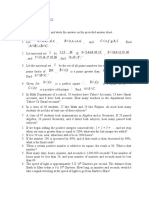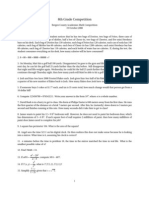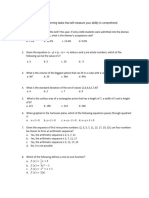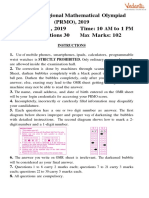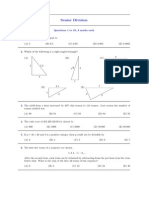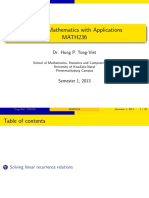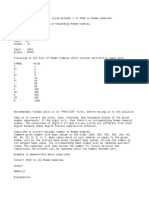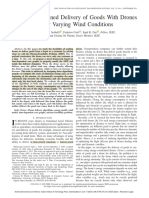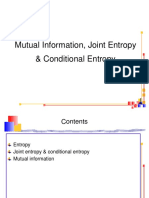Challenge Round
Problem A1. Frederic was born some number of years ago. What is the least positive integer N such that,
on Frederic’s birthday when he turns N years old, it is guaranteed that he has had a birthday (including the
day he was born) fall on every day of the week at least once?
π2
Problem A2. Given that the sum of the reciprocals of all the positive perfect squares is 6 , find the sum of
the reciprocals of all the odd positive perfect squares.
Problem A3. Four pirates had a pile of gold doubloons. During the night, one man woke up and decided
to take his share of the booty. He divided them into four piles and took one pile for himself. One doubloon
was left over so he threw it into the sea. Soon a second man woke up and did the same thing. After dividing
the booty into four piles, one doubloon was left over which he threw into the sea. The third and fourth man
followed exactly the same procedure. The next morning, after they all woke up, they divided the remaining
doubloons into four equal shares. One remained, which they threw into the sea. What is the least number of
doubloons there could have been in the original pile?
Problem A4. Matthew flips a fair coin until it lands heads heads heads, or it lands tails heads tails. What
is the probability that he stops because he flips heads heads heads?
Problem A5. In the addition problem
G
AL I LEO
G
AL I LEO
G
AL I LEO
G
AL I LEO
G
AL I LEO
+ FIG ARO
20222 202
each letter represents a different nonzero digit. Compute the seven-digit number G ALI LEO.
Problem C1. How many ways are there to pair up all of the vertices of a regular octagon such that, if you
draw straight lines connecting the vertices in each pair, no two lines intersect?
Problem C2. Baba and Keke each independently and randomly pick a positive two-digit integer (from 10
to 99 inclusive). Find the probability that Baba’s integer divides Keke’s integer.
Problem C3. Eight distinguishable people sit in a circle and all spin a spinner with an equal chance of
landing on red, blue, or yellow. In how many ways can they spin such that no two adjacent people spin the
same color?
� Problem C4. Consider an arrow on a number line pointing in the positive x direction with length 1. Every
second, it either moves to the right as many times as its length, or it multiplies its length by 35 with equal
probability. After a long time, the expected position of the base of the arrow is x. Compute x.
Problem C5. Find the number of distinct words that use the letters in "OWOUWUUWO" such that no
word has more of one letter than in "OWOUWUUWO". For example, "OWOOU" and "OW" are legal while
"UUWUU" is not. Words cannot be empty.
Problem G1. Triangle ABC has AB = 12, AC = 5 and BC = 13, and M is the midpoint of side AB . Compute
the area of triangle AMC .
A M B
Problem G2. Let n be a positive integer at least 3. What is the probability that it is possible to construct a
line segment of length a from the center C of a regular n-gon to a point P on the perimeter such that a 2 π is
the area of the n-gon?
Problem G3. Triangle ABC has AB = 12, AC = 5 and BC = 13, and M is the midpoint of side AB . Point I is
the center of the inscribed circle of triangle ABC (the circle lying inside triangle ABC and tangent to all three
of its sides) and point E is the center of the circle outside triangle ABC , and tangent to side AB and to the
lines containing sides AB and BC . (This circle is called an escribed circle.) Compute the area of quadrilateral
AI M E .
C
I
M
A B
E
� Problem G4. A circle of radius 3 with an arrow facing up drawn on it is internally tangent to another circle
with radius 12. Let the inner circle roll along the inside the outer circle. When the arrow faces up for the first
time after it starts rolling, what is the degree measure of the arc of the big circle that it has rolled along?
Problem G5. Triangle ABC has AB = 12, AC = 5 and BC = 13, and M is the midpoint of side AB . Point O
is the midpoint of side BC , and point S is the point on side BC such that AS ⊥ BC . Point G is the intersection
of segments AO and C M , and point U is the reflection of point G over line BC . Compute the area of pentagon
U S AMO.
C
S U
G
M
A B
Problem N1. Name goes to random.org and generates a random number n from 50 to 99 (inclusive), and
takes the sum of all the prime factors to the maximum power which still divides n. Name sees that this sum is
an astoundingly low 14. Find the least possible value of n.
Problem N2. What is 2 more than 2 times the number of divisors of the answer to this problem?
Problem N3. Cardigan and Backyardigan are trying to solve a math problem that reads “Compute the
c
number of positive integer divisors of a b .", where a, b, c are some fixed positive integers. Cardigan solves
c
the problem correctly by reading the iterated exponent as a (b ) , and gets an answer of 7400. Backyardigan,
however, incorrectly reads the iterated exponent as (a b )c , but makes no mistakes other than that, and gets an
answer of 645. Given this information, compute b c .
Problem N4. Let p = 1997 be a prime number. The pair of integers (A, B ) = (1, 412) has the remarkable
property that A 2 + B 2 is divisible by p. There exist positive integers a and b such that a 2 + b 2 = p. Compute
a + b.
� Problem N5. Let d 0 (n) be the number of non-trivial divisors (i.e., divisors other than 1 or n) of the positive
integer n, and let S be the set of all positive integers which are not divisible by any primes greater than 5. Find
0
the sum of d n(n) over all elements n of the set S.
Problem Who Even Knows What This Is 0. The product of the areas of all non-degenerate triangles with
integer side lengths a, b, and c for which a, b, c ≤ 10 and the solutions to the pequation ax 2 + bx + c = 0 are all
r s
rational can be expressed as a common fraction in simplest radical form as t . What is the value of s?

























